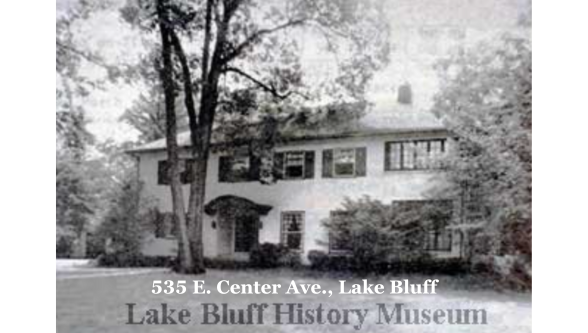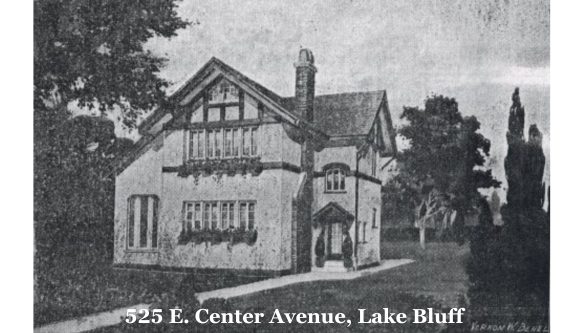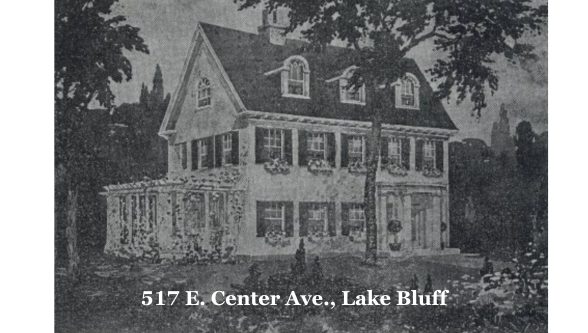Lake Bluff history often intersects with world events and the people behind them. The origin of 517 E. Center Avenue is a great example of this.
The stately Colonial was designed in 1915 by Lake Bluff architect Vernon W. Behel for Mrs. P.H. Linneen, matriarch of a family that summered and eventually settled in Lake Bluff. It’s one of the three “Hyde Park Homes” on the street, so called because the families who commissioned them were friends and neighbors from the Chicago neighborhood of that name. The houses are important because they were built during Lake Bluff’s transition from summer resort to suburban village, and they were sited across the street from the Lake Bluff Country Club, then the social hub of village life.
The story of 517 E. Center begins with Patrick Henry Linneen, who lived through many notable 19th century events long before the house was even imagined. He was born in Ireland in 1844 at the start of the Great Potato Famine; emigrated to upstate New York as a youngster; worked as an errand boy on the Erie Canal, and moved to Chicago in the years after the Great Chicago Fire as western manager of the water pumping company that built the Hyde Park Waterworks plant.
Patrick settled on the South Side with his first wife and three children on a salary of $10,000 a year – around $385,000 in today’s dollars. His wife died in 1892 when the children, Nellie, David and William, were young adults. A few years later, Patrick married Nellie Wilson (same first name as his daughter) of Brooklyn and had one more son, Henry W. Linneen.
In 1897 something horrible happened to Patrick: He was struck by an Illinois Central train at the 39th Street depot in Chicago while trying to warn two travelers to get off the tracks. He was 53 years old. News of his death was carried by many papers, which described him as: “a fine-looking specimen of manhood and a valued employee. …“one of the most upright and conscientious men” … “very well known all over the United States for being an expert in his line.”
Patrick’s widow Nellie was 29 when she became head of the family, just three years older than her eldest stepchild, Nellie Shea, whose wedding took place a week before Patrick was killed.
Widow Nellie lived with her son and stepsons in Chicago for several years, spending time in Lake Bluff during the summers. (Lake Bluff Camp Meeting ended in 1895, but the village remained a popular vacation spot for many years.) By 1915 when she commissioned Behel to design 517 E. Center, Nellie was “one of Lake Bluff’s most prominent and highly regarded residents,” per the Lake Bluff Chat. The newspaper wrote favorably of the house: “None of the details that are typical of the Colonial period have been overlooked.”
Behel was an esteemed architect who designed at least one of the other Hyde Park Homes, 525 E. Center, for John Gray Magaw in 1915. It’s likely Behel was also the architect for 535 E. Center, commissioned in 1910 by Mr. & Mrs. C.H. Pattison, summer visitors from Hyde Park. They named their home “Kenloche,” which in Gaelic roughly translates to headland, or bluff, by the lake.
Multiple generations of the Linneens lived together at 517 E. Center over the years, including matriarch Nellie, her son Henry and the families of her stepsons David and William, whose wives — Beatrice and Mary — were active in Lake Bluff Woman’s Club and the founding of the Lake Bluff Library. The house is where Henry went in 1917 to recuperate from “blood poisoning to the leg” when he was a student at University of Illinois, and it’s where he and William lived when they were drafted into World War I.
Nellie used the house as an income generator, often renting it to summer vacationers. The family would stay at other homes, including at least one summer at 550 E. Center Ave., owned by vaudeville and movie mogul John J. Murdock.
In September of 1920, Henry married Mary Irene Schumann of North Chicago. She was private secretary for Carl Pfanstiehl, president of the Special Chemicals Co., whose work led to advances in the auto industry, radio technology, and military equipment. In 1928, another of his companies, Fansteel Products Co. Radio Laboratory, operated out of 611 Walnut Avenue, the knobby white building in the center of downtown Lake Bluff today known as The Walnut House.
In 1923, family matriarch Nellie Linneen died at age 60. William and his family moved to Rogers Park, and Henry and his family moved to Kansas City for his job with Sinclair Oil Co. They rented 517 E. Center to W.E. Acomb, superintendent of American Steel and Wire Mill.
Ten years later, 1933, records show that Henry was back in Lake Bluff and living at the family home, but by 1940 J. Howard Wood and his family resided there; Wood became publisher and chairman of the Chicago Tribune Company. They lived at 517 E. Center for so many years that many long-time residents today still think of the house as “The Wood House.”
Meanwhile, in 1944, the Linneens became even more entrenched in Lake Bluff when Henry and Irene’s daughter Patricia married William B. Harlan, son of construction company owner Earl “Red” Harlan. Harlan and Harlan Homes built 158 custom homes – 141 of them in Lake Bluff.
From the rocky coast of famine-stricken Ireland to Lake Bluff’s Harlen Homes is quite a stretch, and the Linneen family covered it all.
Written by Adrienne Fawcett for Lake Bluff History Museum
February 2025


